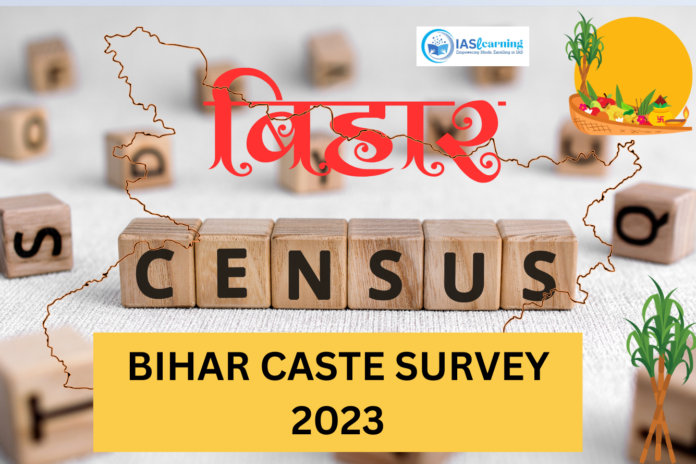Caste has been a deeply ingrained social structure in India for centuries, influencing various aspects of life, including politics, economics, and social interactions.
BIHAR CASTE SURVEY 2023
Affirmative action measures, such as reservations, were introduced to address historical injustices faced by certain caste groups.
- Survey Overview:
- Bihar Jaati Adharit Ganana conducted in 2023.
- Initiated by the Nitish Kumar-led government in January.
- Population Breakdown:
- OBCs and EBCs constitute 63% of Bihar’s total population.
- Other caste groups make up the remaining percentage.
- Nature of the Survey:
- Officially termed a “caste survey.”
- Functions practically as a census.
- Records the state’s population based on individuals’ caste identities.
- Purpose:
- Likely conducted for social welfare programs and affirmative action policies.
- Aims to address historical disadvantages faced by certain caste groups.
- Controversies:
- Caste surveys often raise debates about emphasizing caste identities.
- Discussions regarding the relevance and implications in a modern, diverse society.
- Historical Context:
- The first survey of this kind conducted after independence in Bihar.
- Reflects ongoing efforts to understand and address social dynamics based on caste.
The key findings of the caste survey conducted in Bihar in 2023:
- Total Population Distribution:
- The population of extremely backward and backward classes in the state is 63%.
- Breakdown of Backward Classes:
- Backward class constitutes 27.12% of the total population.
- Extremely Backward Classes:
- Extremely backward class constitutes 36.01% of the total population.
- Scheduled Castes (SC) and Scheduled Tribes (ST):
- Scheduled Castes make up 19.65% of the population.
- Scheduled Tribes account for 1.68% of the population.
- Unreserved Categories:
- Unreserved categories, including Hindus and Muslims, make up 15.52% of the total population.
- Upper Caste Distribution:
- Among the unreserved categories, upper castes (Bhumihar, Brahmins, Rajputs, and Kayasthas) constitute 10.56%.
- Caste Census Initiatives in Other States:
- Caste census initiatives were also undertaken in states like Karnataka, Telangana, and Odisha
- However, these states did not release the census reports.
These findings provide a detailed breakdown of the caste composition in Bihar, highlighting the proportions of various caste groups within the state’s population.
The procedure adopted in the Caste Survey by the Bihar government and the significance of the survey:

Procedure of Caste Survey:
First Phase (January 7 to January 31, 2023):
- Household Survey Initiation:
- Survey of houses commenced on January 7, 2023.
- The first phase was completed by January 31.
- Data Collection:
- Enumerators counted and recorded the total number of household data.
- Data collected based on a set of 17 questions that respondents were required to answer.
Second Phase (April 15 to May 15, 2023):
- Survey Halt and Resumption:
- The second phase was scheduled from April 15 to May 15.
- Counting work stopped on May 4 due to High Court orders and resumed on August 1.
- Calculation was completed within 24 days.
- Information Collected:
- Collected information related to caste, sub-caste, and socio-economic conditions of people in households.
- Data included details on people’s castes, sub-castes, and socio-economic conditions.
- Optional Data:
- Detailed filling of the caste certificate number, ration card number of the head of the family, and Aadhaar number were optional.
Significance of Caste Survey:
- Policy Formulation:
- Considers both caste and economic status for policy formulation.
- A pro-poor exercise for better planning and targeting of welfare schemes.
- Understanding Bihar Society:
- Caste is a significant aspect influencing social interactions, economic possibilities, and political dynamics in Bihar.
- Provides a comprehensive picture of Bihar society.
- Comprehending Social Dynamics:
- A caste census offers insights into the social fabric and interactions among various caste groups.
- Aids in better understanding social dynamics.
- Empowering Political Representation:
- Ensures political representation aligns with the population share of different communities.
- Highlights disparities in representation, as seen in Bihar’s case.
These findings and insights from the caste survey contribute to informed decision-making in policy, social, and political spheres, addressing historical and contemporary issues related to caste dynamics.
Significance and Critique of Caste Survey:
Significance:
- Reducing Inclusion and Exclusion Errors:
- Helps identify actual beneficiaries and minimizes errors in inclusion and exclusion in welfare programs.
- Addressing Disparities:
- Disparities in society, as highlighted by the Muldimensional Poverty Index, can be minimized with proper caste-based data.
- Empowering Marginal Sections:
- Goes beyond reservation issues, empowering vulnerable sections and ensuring fair representation in politics.
- Achieving DPSP Objectives:
- Aids in attaining objectives outlined in the Directive Principles of State Policies (DPSPs) in the Constitution.
- Realizing Sarvodaya Objectives:
- Contributes to achieving socio-economic objectives as outlined by the Constitution’s framers.
- Political Landscape Reshaping:
- Potentially reshapes the political landscape in Bihar, impacting regional political parties.
- Supports demands to lift the Supreme Court’s 50% reservation cap.
Demerits:
- Increased Vote Bank Politics:
- Caste survey data can be manipulated for vote bank politics in upcoming elections.
- Promotion of Caste-Based Voting:
- Encourages voting along caste lines, impacting electoral strategies of political parties.
- Transparency Concerns:
- Integrity of data questioned, with concerns that ruling parties might alter data for political motives.
- Against Casteless Society Ideals:
- Some argue that a caste-based census goes against the idea of a casteless society.
- Caste-Based Reservations Impact:
- Influences political decisions and affiliations related to caste-based reservations in education and government jobs.
- Widening Social Divisions:
- Fear that caste census may widen social rifts and lead to violence, as seen in Maharashtra and Haryana.
Challenges in Court:
- Violation of Right to Privacy:
- Challenged on grounds of violating citizens’ fundamental right to privacy, especially regarding religion, caste, and income queries.
- State’s Competency:
- Contested based on the argument that only the Union government has the power to conduct such a survey.
Modern Context:
- In a technology-based world, data is seen as crucial for socio-economic development.
- Caste and class dynamics play significant roles in Indian politics, particularly in states like Bihar.
- The caste survey can be used to track affirmative action measures and provide a comprehensive view of Indian society.
Conclusion:
- Successful navigation of caste and class dynamics is crucial for politicians in Bihar.
- Thorough analysis needed to balance views for creating a more equal and just society.




